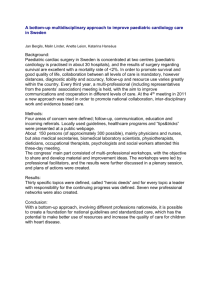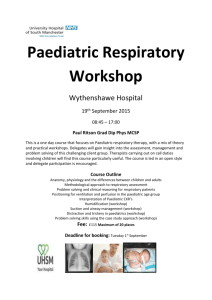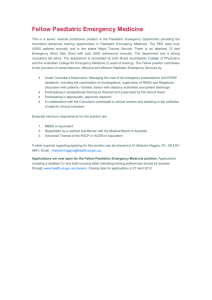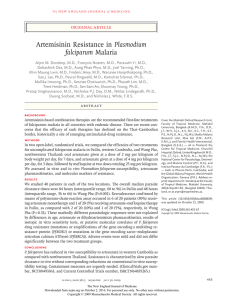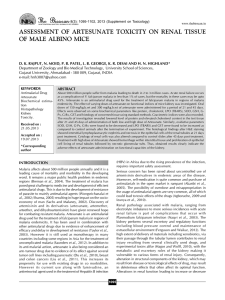British Journal of Pharmacology and Toxicology 1(2): 77-80, 2010 ISSN: 2044-2467
advertisement
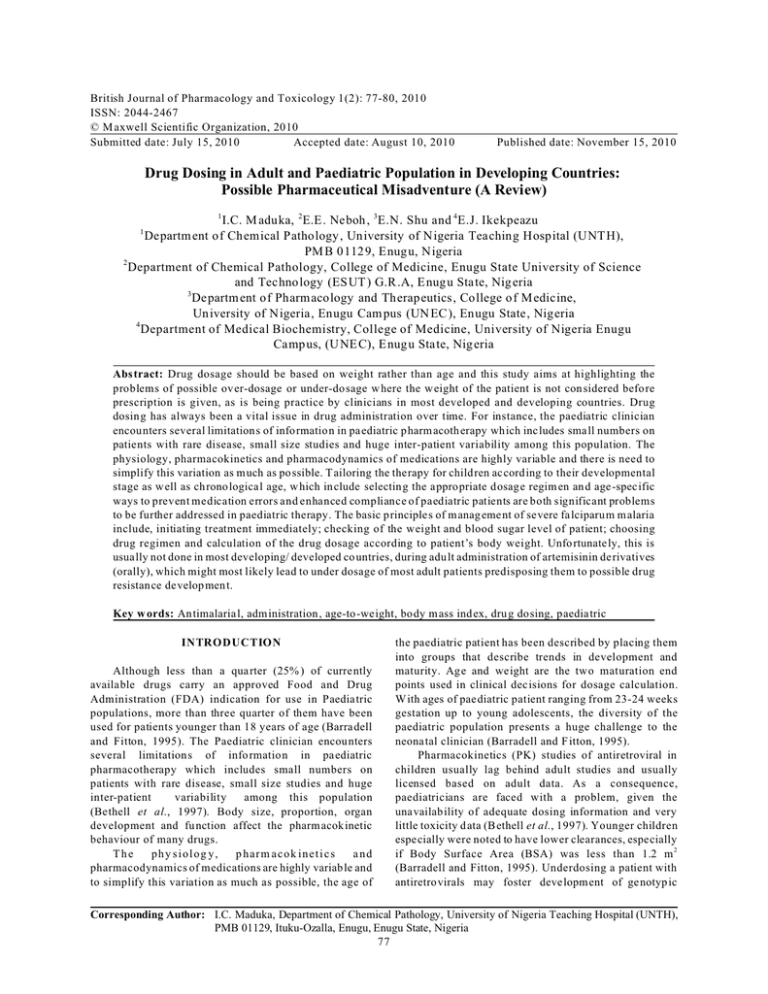
British Journal of Pharmacology and Toxicology 1(2): 77-80, 2010 ISSN: 2044-2467 © M axwell Scientific Organization, 2010 Submitted date: July 15, 2010 Accepted date: August 10, 2010 Published date: November 15, 2010 Drug Dosing in Adult and Paediatric Population in Developing Countries: Possible Pharmaceutical Misadventure (A Review) 1 I.C. M aduka, 2 E.E. Neboh , 3 E.N. Shu and 4 E.J. Ikekpeazu Departm ent of Chemical Pathology , University of Nigeria Teaching Hospital (UNT H), PM B 0112 9, Enug u, Nigeria 2 Department of Chemical Pathology, College of Medicine, Enugu State University of Science and Techno logy (ESUT ) G.R .A, Enug u State, Nig eria 3 Departm ent of Pharmacology and Therapeutics, College o f Medicine, University of Nigeria, Enugu Cam pus (UN EC ), Enugu State, Nigeria 4 Department of Medical Biochemistry, College of Medicine, University of Nigeria Enugu Campus, (U NE C), Enug u State, Nig eria 1 Abstract: Drug dosage should be based on weight rather than age and this study aims at highlighting the problems of possible over-dosage or under-do sage w here the w eight of the patient is not con sidered before prescription is given, as is being practice by clinicians in most developed and developing countries. Drug dosin g has always been a vital issue in drug administration over time. For instance, the paediatric clinician encounters several limitations of information in paediatric p harm acoth erapy which includes small numbers on patients with rare disease, small size studies and huge inter-patient variability among this population. The physiology, pharmacokinetics and pharmacodynamics of medications are highly variable and there is need to simplify this variation as much as possible. T ailoring the therapy for children according to their developmental stage as well as chronological age, w hich include selecting the appropriate dosag e regim en an d age -specific ways to prevent medication errors and enhanced compliance of paediatric patients are both significant problems to be further addressed in paediatric therapy. The basic p rinciples of manag eme nt of severe falciparum m alaria include, initiating treatment immediately; checking of the weight and blood sugar level of patient; choosing drug regimen and calculation of the drug dosage according to patient’s body weight. Unfo rtunately, this is usually not done in most developing/ developed co untries, during adu lt administration of artemisinin de rivatives (orally), which might most likely lead to under dosage of most adult patients predisposing them to possible drug resistance develop men t. Key w ords: Antimalarial, administration, age-to-weight, body m ass ind ex, dru g dosing, paediatric INTRODUCTION Although less than a quarter (25% ) of currently available drugs carry an approved Food and Drug Administration (FDA) indication for use in Paediatric populations, more than three quarter of them have been used for patients younger than 18 years of age (Barra dell and Fitton, 1995). The Paediatric clinician encounters several limitation s of info rmatio n in paediatric pharmacotherapy which includes small numbers on patients with rare disease, small size studies and huge inter-patient variability among this population (Bethell et al., 1997). Body size, proportion, organ development and fu nction affect the pharm acok inetic behaviour of many drugs. The phy siolog y, p h arm aco k in eti c s and pharmacodynamics of medications are highly variable and to simplify this variation as much as possible, the age of the paediatric patient has been described by placing them into groups that describe trends in development and maturity. Age and weight are the two maturation end points used in clinical decisions for dosage calculation. W ith ages of paediatric patient ranging from 23-24 weeks gestation up to young adolescents, the diversity of the paediatric population presents a huge challenge to the neonatal clinician (Barradell and F itton, 1995). Pharmacokinetics (PK) studies of antiretroviral in children usually lag behind adult studies and usually licensed based on adult data. As a consequence, paediatricians are faced with a problem, given the unavailability of adequate dosing information and very little toxicity d ata (Bethell et al., 1997). Younger children especially were noted to have lower clearances, especially if Body Surface Area (BSA) was less than 1.2 m 2 (Barradell and Fitton, 1995). Underdosing a patient with antiretrovirals may foster developm ent of ge notyp ic Corresponding Author: I.C. Maduka, Department of Chemical Pathology, University of Nigeria Teaching Hospital (UNTH), PMB 01129, Ituku-Ozalla, Enugu, Enugu State, Nigeria 77 Br. J. Pharm. Toxicol., 1(2): 77-80, 2010 resistance mutations, w hile overdosing could p otentiate serious adverse effects. Hence the general objective of this review is to throw more light on the pharmaceutical misadventure which most developing countries practice via dosing by the term “adult” and not by the actual w eight, as should be . dosage which might resu lt from w eight variation in adults and children. ARTESUNATE AND AMODIAQUINE DOSAGE REGIMEN:(WEIGHT-FOR-AGE) The world health organization /National centre for health statistics (WH O/NCHS) weight-for-age reference data are based on well nourished populations from developed countries and is suitable for comparing the nutritional status of different population (W HO ,2006). This data set was standardized by age and sex, so that there was equal sex distribution in each 1 year age category, with the age distribution typical of a subsaharan Africa n population, and the convention of doubling the drug dose per age category was followed leading to the selection of first ag e grou ps. These groups had an approximate doubling in median body weight : 0-1months (4.2 kg), 2-11 m onths (6.9 kg ), 1-6 years (13.3 kg), 7-13 years (25.6 kg), and > 14 years (58.0 kg) (WHO , 2006). Control programmes need simple dosing regimens, as comp licated regimen s carry the risk of dosing errors, the effects of which may out-weigh the intended ad vantages of greater accuracy (W HO , 2006). Tablet containing 25 and 100 mg artesunate were chosen because these carried the lowest risk of overdosing; only 1 in 10,000 rec ipient w ould receive >10 mg/kg/day; 1 in 250 would receive >8 mg/k g/day and 1 in 1000 patient <2 mg/kg/day. The same reason ap plied to final choice of strength of the amodiaquine tablets, (WHO, 2006) (67.5 and 270 mg) resulting in only 83.4% of patients predicted to receive therapeutic dose of amodiaquine. The patients that received (<2 mg/kg) Artesuna te also run the risk of developing resistant strains of plasmodium. The proportion of patients predicted to receive therap eutic doses for various tablet strengths of amodiaquine and artesunate usin g the five default age categories are shown in Table 1. Artesunate tablets containing between 25 and 30 mg (paediatric strength) and between 100 and 120 mg (adult strength) would each result in 99.9% of patients receiving doses within the range 2-10 mg/kg/da y. Thus these w ere associated w ith the lowest risk of overdosing and were chosen as therapeutic dose (deVries and Dien, 1996) Multiplying the median weight for each categ ory by the curren tly recomm ended do ses of 1 0 mg /kg/day for amodiaquine and 4 mg/kg/day for artesunate, gives the optimal tablet strength. Dosing accuracy was defined as the proportion of individuals [using Malaria-Weighted Anthropome tric Refe rence (MW AR ) data se t] who were predicted to receive a dose within the therapeutic ranges when dose was based on age using the default age categories described (W HO , 2006). Ideal body weight for an adult: An adult is an individual who is above 21 years of age and has an average weight of 50-60 kg. In a study on body weight and disability among adults 45 years and older, self-reported Body M ass Index (BM I) (kilograms per meter square) w as use d to categorized participants into six BM I-defined groups (Okoro et al., 2004.) under weight (<18.5), normal weight (18.5 to <25), over weight (25 to <30), obese, class 1 (30 to <35 ); obese class 2 (35 to <40), and obese, class 3 ($40) (Okoro et al., 2004 ), indicating the possibility of greater num ber of p atients deviating from the normal weight group and also possible resistance arising as a result of underdose of such individuals. Calculation of the m ale ideal weight (kg) is given by 50+2.3 x (height in inches - 60), while the female ideal weigh t is given by 45+2.3 x (he ight in inches - 60). Artem isinin and derivatives: Artemisinin and its semi synthetic derivatives are potent, well-tolerated compounds that are used as first-line antimalarial therapy in many tropical countries (Barradell and Fitton, 1995; deVries and Dien, 1996). A number of studies have demonstrated the efficacy of artesunate in uncomplicated, severe (Hien et al., 1992a) and multi-drug resistant (Bunnag et al., 1996; Hien et al., 1992b) falciparum malaria, but no similar study has shown the possibility or error resulting from differences in weight of adult patients. Since artesunate clears parasite more rapidly than quinine and may impro ve survival (B arrade ll and Fitton, 1995), intravenous (iv) artesunate has become an alternative to i.v quinine for the treatment of severe malaria in many co untries (Looareesuwan et al., 1992). The pharmacokinetics and pharmacodynamics of artesunate and artemisinin derivatives have been assessed in patients with u ncomplicated m alaria (Bethell et al., 1997 ) and se vere falciparum malaria (Looareesuwan et al., 1992) but yet no equivalent studies on the possibility of weight related error in adult dosage regimen of artesunate. The drug regim en used for patients w ith complications remain empirical and do not differ significa ntly from those used for patients with milder malaria (deVries and D ien, 1996). A lthoug h neu rotoxicity has yet to be dem onstrated ob jectively in human receiving conventional doses of artemisinin drugs, residual concerns rema in (Elias et al., 1999) which is one of the primary reasons for this review, also aimed at avoiding over 78 Br. J. Pharm. Toxicol., 1(2): 77-80, 2010 Tab le 1: Th e ov erall p rop ortion of p atien ts pre dicte d to re ceiv e do sag e w ithin a nd o utsid e the defin ed thera peu tic doses of amodiaquine and artesu nate using different tablet strengths for both drugs and anthropometric data from sub-saharan Africa Am odiaq uine tab lets strength (m g) Therapeutic dose 7.5-15 mg/kg/day -------------------------------------------------------------------------------------------------------------------------------------------------------------Pae diatric table ts Ad ult tab lets Belo w (% ) W ithin (% ) A bo ve (% ) 62 .5 250 17 .6 77 .4 5.1 65 260 13 .5 79 .9 6.6 67 .5 270 10 .0 81 .9 8.2 70 280 8.4 81 .1 10 .5 72 .5 290 5.5 81 .8 12 .7 75 300 4.1 81 .3 14 .6 77 .5 310 3.4 78 .8 17 .9 Artesunate tablets strength (mg) Therapeutic dose 2-10 mg/kg/day -------------------------------------------------------------------------------------------------------------------------------------------------------------Pae diatric table ts Ad ult tab lets Belo w (% ) W ithin (% ) A bo ve (% ) 20 80 4.1 95 .9 0 22 .5 90 1.7 98 .3 0 25 100 0.1 99 .9 0.01 27 .5 110 0.06 99 .9 0.03 30 120 <0.01 99 .9 0.1 32 .5 130 <0.01 99 .5 0.5 35 140 0 99 .0 1.0 For artesunate, dosing accuracy was very insensitive to changes in age cut-off points, in contrast to that of amodiaquine. Models run with 8 mg/kg as the upper cutoff points for artesu nate provided the same age cut-off points as the models that used 10 mg/kg/day as the upper threshold (data not show n) (W HO , 2006). Nevertheless, an evaluation of the tolerability of this fixed artesunate and amodiaquine combination will be necessary in further clinical trials and when deployed widely, by pharma covigilance (WHO , 2006). done in most developing cou ntries, du ring ad ult administration of artemisinin derivatives (orally), which might most likely lead to under dosage of most adult patients predisposing them to possible drug resistance developm ent. RECOMMENDATION Drug dosage should be based on weight rather than age as is being practice in most developed and developing countries. Also clinicians and drug com panies sho uld desist from using the term “adult” in dosing procedures to avoid the problems of possible over dosage or under dosage where the weight of the patient is not considered before prescription is given. CONCLUSION The pharmacokinetics of artesunate and dihyd roartem isinin are not influence by the severity of the malaria infection (Hien et al., 1992b). Tailoring the therapy for children according to their developmental stage as well as chronological age, which include selecting the appro priate dosage regimen and agespecific ways to prevent medication errors and enhanced compliance of paediatric patients are both significant problems to be further addressed in paediatric therapy (Angus et al., 2002 ). This is usually taken care of by high specificity of age and weight co nsideration in paed iatric dosage regimen, unlike that of adults. T he gre at need to prevent pharma ceutical misadventures in pa ediatric patients presents opportunities for scientists to participate in the provision of pharmaceutical care for paediatrics (Bunnag et al., 1996 ). Thus paediatric clinicians must always adhere. The basic principles of managemen t of severe falciparum mala ria include, initiating treatment immediately; checking of the weight and blood sugar level of patient; choosing drug regimen and calculation of the drug dosage according to patient’s body weight (Anony mous, 2002). This unfortunately is usually not REFERENCES Angus, B.J., I. Thaiaporn, K. Clanthapadith, Y. Suputtamongkol and N. White, 2002. Oral artesunate dose-response relationship in acute f a l c ip a r u m m a l a r ia . A n t i m ic r o b. A g e n ts . Chemo ther., 46(3): 778-7 82. PMID: 11850261, doi: 10.1128/AAC.46.3.778-782.2002. Anony mous, 2002. Malaria in Armenia. Retrieved from: www.Ghazanchyan.com. Barradell, L.B. and A. Fitton, 1995. Artesunate. A review of its pharmacology and therapeutic efficacy in the treatment of malaria. Drugs, 50(4): 71 4-774. doi: 10.2165/00003495-199550040-00009. Bethell, D.B ., P. Teja-Isavadharm, X.T. Cao, T.T . Phar, T.T. Ta and T.N. Tran, 1997. Pharmacokinetics of oral artesunate in children with moderately severe plasmodium falciparum malaria. Trans. R. Soc. T r o p . M e d . H y g . , 9 1 : 1 1 9 5 - 1 1 9 8. d o i: 10.1016/S0035-9203 (97) 90222-4. 79 Br. J. Pharm. Toxicol., 1(2): 77-80, 2010 Bunnag, D., T. K anda, J. Karb wa ng, K. Thimasarn, S. Pungpak and T. Harinasuta, 1996. Artemether or artesunate followed by mefloquin e as possible treatment for multidrug resistant falciparum malaria. Trans. R. So c. Trop. M ed. H yg., 90 : 198-2 05. do i: 10.1016/S0035-9203 (96) 90529-5. deVries, P.J. and T.K. Dien, 1996. Clinical pharmacology and therapeutic potential of artem isinin an d its derivatives in the treatment of malaria. Drugs, 52: 818-836. doi: 10.2165/00003495-199652060-0004. Elias, Z., E. Bon net, B. M archou and P. Massip, 1999. Neurotoxity of artemisinin; possible counseling and treatment side effects. Clin. Infec. Dis., 28: 1330-1331. doi: 10.1086/517789. Hien, T.T., K. Arnold, H. Vinh, B.M. Cuong, N.H. Phu, T.T. Chau, N .T. Hoa, L.V. C huong, N .T. M ai and N.N. Vinh, 1992a. Comparison of artemisinin supp ositories with intravenous artesunate and intravenous quinine in the treatment of cerebral malarial. Trans. R. Soc. Trop. M ed. Hy g., 86(6): 582-583. doi: 10.1016/0035-9203 (92) 90137-2. Hien, T.T., N.H. Phu, N.T. Mai, T.T. Chau, T.T. Trang, P.P. Loc, B.M. Cuong, N.T. Dung, H. Vinh and D .J. W aller, 1992b. An open randomized comparison of intravenous and intramuscular artesunate in severe falciparum malaria. Trans. R. Soc. Trop. Med. H yg., 86(6): 584-585. Loo areesuwan, S., C. Virav an, S. Vanijanonta, P. W ilairatana, P. Suntharasam ai, P. Charoenlarp, K. Arnold, D . Kyle, C. Canfield and K. Webster, 1992. Ran dom ised trial of artesunate and m efloquine alone and in sequence for acute uncomplicated falciparum malaria. Lancet, 339(8797): 821-824. PMID: 1347854. Okoro, C.A ., J.M. Hootman, T.W. Strin, L.S. Balluz and A.H. Mokda d, 2004. Disability, arthritis and body weight among adults 45 years and older. O besity Res., 12(5): 854-861. doi: 10.1038/oby.2004.103. WHO, 2006. Use of weight-for-age data to optimize tablet strength and dosing regimens for a new fixeddose artesunate-amodiaquine co mbination for treating falciparum malaria. Bull. World H ealth O rg., 84(12): 956 -964. 80
